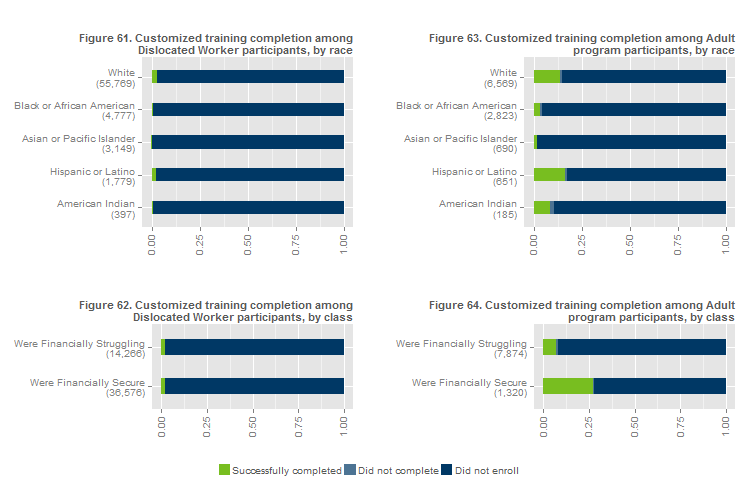Figures 61 through 64 show the rate of on-the-job or other customized training completion.

Customized training in general refers to training that occurs on a work site, supervised if not provided by an employer. The most common type of customized training in these programs is on-the-job training. On-the-job training in this context refers to a contractual agreement between the workforce development agency and an employer-the employer agrees to employ and train the participant, and the workforce development agency agrees to reimburse a portion of the participant's wages (50% or more, depending on various criteria).
This program acts as an incentive to hire, which can be especially valuable for participants with barriers to employment. Sue Hilgart, Rural Minnesota CEP Team Leader at the Brainerd WorkForce Center said:
"[Participants engaged in on-the-job training learn] teamwork and all of those kinds of things that you can tell people about in a lecture form, or in a workshop, but it's much more transferable when they're experiencing it and getting a paycheck for it. So the combination of that exposure to work and a paycheck is a very valuable experience for anybody who is coming with a spotty work history or no work history or something in their background."
Overall, despite many areas' active promotion of this strategy, actual on-the-job training completion rates are low among Dislocated Workers. Rates range from virtually 0% among American Indian, Asian or Pacific Islander, and Black or African American participants, to 3% among white participants (Figure 61). There is very little difference in completion rates by class (Figure 62).
Rates among Adult participants are higher, but differences by both race and class are also more pronounced. Completion rates range from a low of 2% among Asian or Pacific Islander participants to a high of 16% among Hispanic participants (Figure 63).
Even more striking, completion rates range from 7% among those who were financially struggling prior to participation to 27% among those who were financially secure (Figure 64).
Interestingly, rates of 'Did not complete' are much lower for on-the-job training than for any other training type.